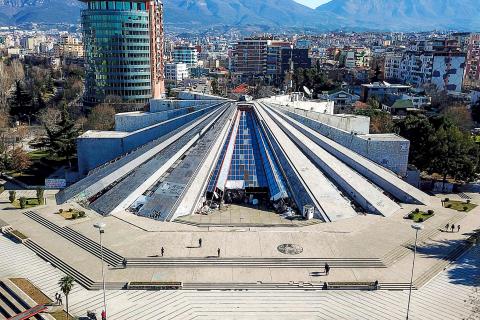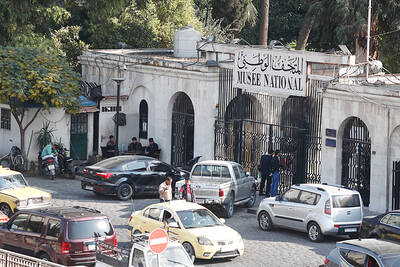The sprawling, space-age “pyramid” in Tirana’s center had many uses before falling into ruin: Built as a museum for a dictator, it later hosted a NATO base, TV studio, nightclub and more.
After years of neglect, the crumbling structure is now set for another rebirth as an information technology hub in the heart of Albania’s fast-changing capital.
“I don’t think there is anyone who thinks it is beautiful, but it’s a sort of a landmark of the city and people want to preserve them in a city that has lost a lot” to development, said Joni Baboci, a city hall architect involved with the redesign.

Photo: AFP
The 11,400m2 behemoth has triangular wedges of graffiti-covered marble and dark window panes that meet at a peak, giving it the pyramid look.
For the project’s architects, its overhaul is about striking a balance between preserving and reclaiming a relic from a dark period of Albanian history.
The bizarre building was erected 30 years ago to glorify the life of then-dictator Enver Hoxha, who ruthlessly ruled Albania for four decades until his death in 1985.
After communism collapsed a few years later, the museum was shuttered and the pyramid became a venue for a merry-go-round of uses, reflecting the explosion of culture in a nation that had been hermetically sealed under Hoxha’s iron grip.
However, for the past 10 years the building has sat virtually abandoned, aside from the locals and tourists who can be seen scaling its walls for the 360° city view at the top.
When authorities announced plans to demolish the pyramid several years ago, protests broke out, revealing how the unusual monument had won its way into people’s hearts.
The demolition plan was scrapped and city hall came back last year with a project to turn the pyramid into a digital learning center.
“We thought there couldn’t be a better symbol than giving the building back to Albanian society in its best form, to the kids, for their future education,” said Martin Mata, of the Albanian-American Development Foundation, which is funding the more than US$10 million renovation.
It is a fitting purpose for a nation suffering from high youth unemployment and emigration rates.
Designs revealed last month by Dutch firm MVRDV open the structure on all sides of the ground floor, bring light into the atrium with more glass, surround it with trees and carve stairs onto its exterior to make the pyramid walls a safer climb.
“The pyramid will be open to everyone” and the building will be nearly “transparent,” chief architect Winy Maas said at a presentation in Tirana.
Inside will be a mix of commercial space and a learning center for young people, run by non-profit group Tumo, offering classes in computer programming, design and other digital skills.
For Tirana Mayor Erion Veliaj the project is a “story of resurrection” — for the pyramid and Albania itself.
“Since the fall of the Berlin Wall and the start of [Albania’s] transition, the question has been how do we make Albania great again?” he said.
The pyramid’s renovation is part of a dizzying amount of transformation that the nation’s capital has undergone.
The collapse of communism unleashed a massive wave of migration from rural areas to the capital, leading to unchecked construction, an explosion of vehicles and chaotic urban spaces.
As mayor of Tirana in the early 2000s, Albanian Prime Minister Edi Rama gave the city a major facelift by splashing its drab communist buildings with bright colors and bold patterns.
Veliaj says he is trying to further spruce up the city by cracking down on illegal construction, creating more parks and turning a massive Skanderbeg Square traffic roundabout into a pedestrian space.
The changes are raising Tirana’s profile on the tourist map.
Its vibrant cafe scene now comes in for praise, as well as the unique hodgepodge of architecture, including Italian fascist buildings, Soviet-style tower blocks, Ottoman-era mosques and, of course, the pyramid, but not all of city hall’s revamps are popular.
There have been regular protests in the last year over plans to knock down homes and shops for a ring road.
In the city center, a crowd has been demonstrating daily against a government-backed project to bulldoze Tirana’s national theater, built in 1930, and replace it with a modern one.
As for the pyramid, some would have preferred to see it become an archeology museum or national library, among other things, but for Rama, the transformation of a “symbol of dictatorship” to a “symbol of each individual’s power in a new time” is an apt road map.
“I am happy that we have managed to solve a problem that has vexed us for 30 years now,” he said.

Philippine President Ferdinand Marcos Jr yesterday vowed that those behind bogus flood control projects would be arrested before Christmas, days after deadly back-to-back typhoons left swathes of the country underwater. Scores of construction firm owners, government officials and lawmakers — including Marcos’ cousin congressman — have been accused of pocketing funds for substandard or so-called “ghost” infrastructure projects. The Philippine Department of Finance has estimated the nation’s economy lost up to 118.5 billion pesos (US$2 billion) since 2023 due to corruption in flood control projects. Criminal cases against most of the people implicated are nearly complete, Marcos told reporters. “We don’t file cases for

A feud has broken out between the top leaders of the far-right Alternative for Germany (AfD) party on whether to maintain close ties with Russia. The AfD leader Alice Weidel this week slammed planned visits to Russia by some party lawmakers, while coleader Tino Chrupalla voiced a defense of Russian President Vladimir Putin. The unusual split comes at a time when mainstream politicians have accused the anti-immigration AfD of acting as stooges for the Kremlin and even spying for Russia. The row has also erupted in a year in which the AfD is flying high, often polling above the record 20 percent it

Ecuadorans are today to vote on whether to allow the return of foreign military bases and the drafting of a new constitution that could give the country’s president more power. Voters are to decide on the presence of foreign military bases, which have been banned on Ecuadoran soil since 2008. A “yes” vote would likely bring the return of the US military to the Manta air base on the Pacific coast — once a hub for US anti-drug operations. Other questions concern ending public funding for political parties, reducing the number of lawmakers and creating an elected body that would

‘ATTACK ON CIVILIZATION’: The culture ministry released drawings of six missing statues representing the Roman goddess of Venus, the tallest of which was 40cm Investigators believe that the theft of several ancient statues dating back to the Roman era from Syria’s national museum was likely the work of an individual, not an organized gang, officials said on Wednesday. The National Museum of Damascus was closed after the heist was discovered early on Monday. The museum had reopened in January as the country recovers from a 14-year civil war and the fall of the 54-year al-Assad dynasty last year. On Wednesday, a security vehicle was parked outside the main gate of the museum in central Damascus while security guards stood nearby. People were not allowed in because